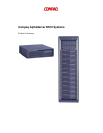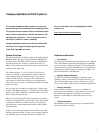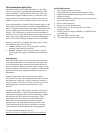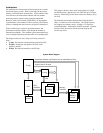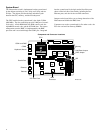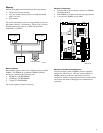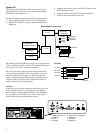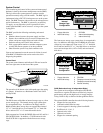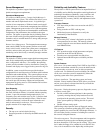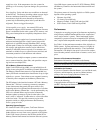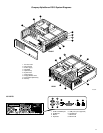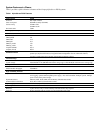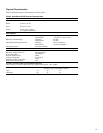8
Server Management
The AlphaServer products support important operational and
platform management requirements.
Operational Management
Server/Network Management. Compaq Insight Manager is
included with every system. This software tool allows you to
monitor and control Alpha based servers. Insight Manager
consists of two components: a Windows-based console appli-
cation and server- or client-based management data collection
agents. Management agents monitor over 1,000 management
parameters. Key subsystems are instrumented to make health,
configuration, and performance data available to the agent
software. The agents act upon that data, by initiating alarms in
the event of faults and by providing updated management in-
formation, such as network interface or storage subsystem per-
formance statistics.
Remote Server Management. The integrated remote manage-
ment console (RMC) lets the operator perform several tasks
from a serial console: monitor the system power, temperature,
and fans, and reset, halt, and power the system on or off. The
monitoring can be done locally or remotely through a modem.
Platform Management
The AlphaServer DS10 systems support platform management
tasks such as manipulating and monitoring hardware perform-
ance, configuration, and errors. For example, the operating
systems provide a number of tools to characterize system per-
formance and display errors logged in the system error log file.
In addition, system console firmware provides hardware
configuration tools and diagnostics to facilitate quick hardware
installation and troubleshooting. The system operator can use
simple console commands to show the system configuration,
devices, boot and operational flags, and recorded errors. Also,
the console provides inventory support and configuration
management by giving access to serial numbers and revisions
of hardware and firmware.
Error Reporting
Compaq Analyze, a diagnostic service tool used to determine
the cause of hardware failures, is installed with the operating
systems. It provides automatic background analysis, as it
constantly views and reads the error log file. It analyzes both
single error/fault events and multiple events. When an error
condition is detected, it collects the error information and
sends it and an analysis to the user. The tool requires a
graphics monitor for its output display.
Security
• The top cover can be locked with a key.
• Password protection is offered by the SRM console and
RMC.
Reliability and Availability Features
The AlphaServer DS10 system achieves an unparalleled level
of reliability and availability through the careful application of
technologies that balance redundancy, error correction, and
fault management. Reliability and availability features are
built into the CPU, memory, and I/O, and implemented at the
system level.
Processor Features
• CPU data cache provides error correction code (ECC)
protection.
• Parity protection on CPU cache tag store.
• Multi-tiered power-up diagnostics to verify the
functionality of the hardware.
Memory Features
• The memory ECC scheme is designed to provide maxi-
mum protection for user data. The memory scheme
corrects single-bit errors and detects double-bit errors and
total DRAM failure.
I/O Features
• ECC protection on the switch interconnect and parity
protection on the PCI and SCSI buses.
• Extensive error correction built into disk drives.
• Optional internal RAID improves reliability and data
security.
System Features
Auto reboot. On systems running Tru64 UNIX or OpenVMS, a
firmware environment variable lets you set the default action
the system takes on power-up, reset, or after an operating
system crash. For maximum system availability, the variable
can be set to cause the system to automatically reboot the
operating system after most system failures.
Software installation. The operating systems are factory
installed. Factory installed software (FIS) allows you to boot
and use your system in a shorter time than if you install the
software from a distribution kit.
Diagnostics. During the power-up process, diagnostics are run
to achieve several goals:
• Provide a robust hardware platform for the operating
system by ensuring that any faulty hardware does not
participate in the operating system session. This maxi-
mizes system uptime by reducing the risk of system
failure.
• Enable efficient, timely repair.
Audible beep codes report the status of diagnostic testing.
The system has a firmware update utility (LFU) that provides
update capability for console and PCI I/O adapter firmware. A
fail-safe loader provides a means of reloading the console in
the event of corrupted firmware.
Thermal management. The air temperature and fan operation
are monitored to protect against overheating and possible
hardware destruction. Four fans provide cooling. The system
fan is under the floppy drive; another fan cools the PCI area.
Also, a fan is mounted over the Alpha chip, and the power



